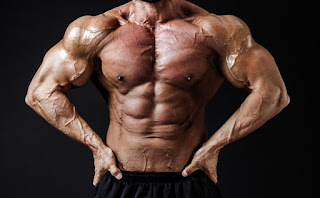Hypertrophy normally means enlargement or increase in size of a particular organ or tissue by the increase in size of cells. The cells usually increases in size in response to several environmental changes like hormonal stimulation, inflammation, or increased workload. Two factors contribute to hypertrophy: sarcoplasmic hypertrophy, which focuses more on increased muscles glycogen storage; and myofibrillar hypertrophy, which focuses more on increased myofibril size. But in this article i am going to discuss about the science of hypertrophy with respect to bodybuilding.
The principles on which hypertrophy in bodybuilding depends are:
1. Mechanical load: Mechanical Load is necessary to induce muscle hypertrophy. This mechanism involves satellite cells, growth factors, calcium, and number of other fairly understood factor. It is incorrect to say "we don't know how muscle grows in response to training." .
2. Acute vs chronic stimuli: In order for the loading to result in hypertrophy, the stimulus must be applied with sufficient frequency to create a new "environment", as opposed to seemingly random and acute assaults on the mechanical integrity of the tissue. The downside of taking a week of rest every time you load a muscle is that many of the acute responses to training like increased protein synthesis, prostaglandis, IGF-1 levels, and mRNA levels return to normal in about 36 hours. So, you spend two days growing and half a week in a semi-anticatabolic state returning to normal (some people call this recovery), when research shows us that recovery can take place unabated even if a muscle is loaded again in 48 hours. So true anabolism from loading only lasts two days at best once the load is removed. The rest of the time you are simply balancing nitrogen retention without adding to it.
3. Progressive Load: Over time, the tissue adapts and becomes resistant to the damaging effects of mechanical load. This adaptation (resistance to the stimulus) can happen in as little as 48 hours (repeated bout or rapid training effect). As this happens, hypertrophy will stop, though neural and metabolic adaptations can and may continue. As opposed to hypertrophy, the foundation for the development of strength is neuromuscular in nature. Increases in strength from resistance exercise have been attributed to several neural adaptations.
4. Strategic deconditioning: At this point, it is necessary to either increase the load (progressive load), or decrease the degree of conditioning to the load (strategic deconditioning). The muscle is sensitive not only to the change in load (up or down). Therefore, you can get a hypertrophic effect from increasing the load from previous load, even if the obsolete load is not maximum, assuming conditioning (resistance to exercise induced micro-damage) is not to extensive. There is a limit to the number of increaments you can add to increase the load. You simply reach your maximum voluntary strength eventually. This is why strategic deconditioning is required for continued growth once growth has stopped.
The principles on which hypertrophy in bodybuilding depends are:
1. Mechanical load: Mechanical Load is necessary to induce muscle hypertrophy. This mechanism involves satellite cells, growth factors, calcium, and number of other fairly understood factor. It is incorrect to say "we don't know how muscle grows in response to training." .
2. Acute vs chronic stimuli: In order for the loading to result in hypertrophy, the stimulus must be applied with sufficient frequency to create a new "environment", as opposed to seemingly random and acute assaults on the mechanical integrity of the tissue. The downside of taking a week of rest every time you load a muscle is that many of the acute responses to training like increased protein synthesis, prostaglandis, IGF-1 levels, and mRNA levels return to normal in about 36 hours. So, you spend two days growing and half a week in a semi-anticatabolic state returning to normal (some people call this recovery), when research shows us that recovery can take place unabated even if a muscle is loaded again in 48 hours. So true anabolism from loading only lasts two days at best once the load is removed. The rest of the time you are simply balancing nitrogen retention without adding to it.
3. Progressive Load: Over time, the tissue adapts and becomes resistant to the damaging effects of mechanical load. This adaptation (resistance to the stimulus) can happen in as little as 48 hours (repeated bout or rapid training effect). As this happens, hypertrophy will stop, though neural and metabolic adaptations can and may continue. As opposed to hypertrophy, the foundation for the development of strength is neuromuscular in nature. Increases in strength from resistance exercise have been attributed to several neural adaptations.
4. Strategic deconditioning: At this point, it is necessary to either increase the load (progressive load), or decrease the degree of conditioning to the load (strategic deconditioning). The muscle is sensitive not only to the change in load (up or down). Therefore, you can get a hypertrophic effect from increasing the load from previous load, even if the obsolete load is not maximum, assuming conditioning (resistance to exercise induced micro-damage) is not to extensive. There is a limit to the number of increaments you can add to increase the load. You simply reach your maximum voluntary strength eventually. This is why strategic deconditioning is required for continued growth once growth has stopped.
SOURCE: www.bodybuilding.com

No comments:
Post a Comment